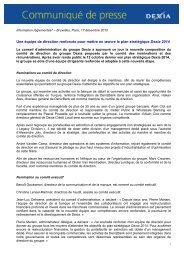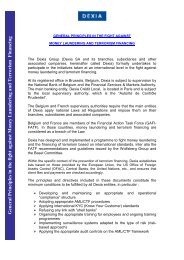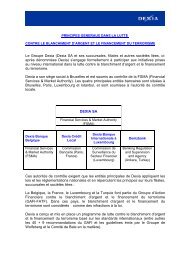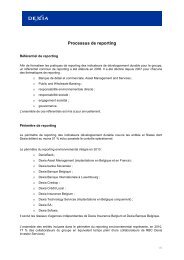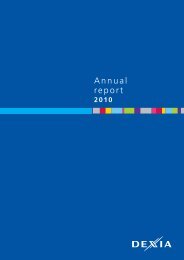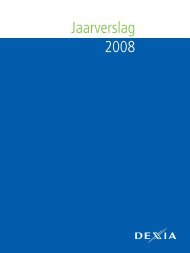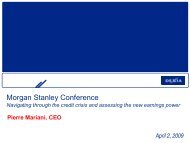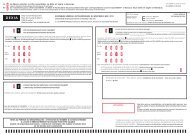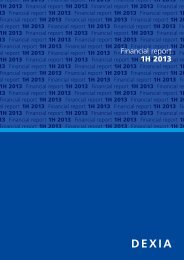Annual report 2009 - Dexia.com
Annual report 2009 - Dexia.com
Annual report 2009 - Dexia.com
- No tags were found...
You also want an ePaper? Increase the reach of your titles
YUMPU automatically turns print PDFs into web optimized ePapers that Google loves.
Risk managementBond portfolio<strong>Dexia</strong> manages bond portfolios, largely in run-off, amountingto EUR 165.5 billion as at 31 December <strong>2009</strong> (as <strong>com</strong>paredto EUR 181.2 billion as at 31 December 2008).The interest-rate risk of these credit-spread portfolios is verylimited, as interest-rate risk is hedged.As at 31 December <strong>2009</strong> the sensitivity in fair value after a basispoint credit-spread increase amounted to EUR -115.7 millionfor the (banking) bond portfolio (against EUR -129.7 million/basis point as at 31 December 2008 (1) ).Given the illiquidity of markets and the reduced possibility ofhaving “observable” prices/spreads in the valuation process,a mark-to-model valuation development was performed onthe illiquid part of the available-for-sale bond perimeter asfrom year-end 2008.The credit spreads provided by the model are based on thecredit <strong>com</strong>ponent plus a liquidity premium. Methodologicaland operational improvements were made during <strong>2009</strong> onthe advanced mark-to-model for the illiquid available-for-saleperimeter. As at 31 December <strong>2009</strong>, the advanced mark-tomodelhas also been applied on the reclassified loans andreceivables bond perimeter for IFRS disclosures.Balance-sheet managementDefinitionBalance-Sheet Management (BSM) risks include both structuralmarket risk (structural interest-rate risk, specific interestraterisk – credit-spread risk –, foreign-exchange risk, equityrisk generated off and on-balance sheet by the <strong>com</strong>mercialbusiness lines) and liquidity risk.We refer to the part on Market Risks for detailed definitionsof structural and specific interest-rate risk, foreign-exchangerisk, equity risk.The liquidity risk is defined as the probability of the bankbeing unable to cover its expected and unexpected currentand future liquidity requirements.GovernanceCommitteesOverall BSM risks are managed by the <strong>Dexia</strong> Group Assets& Liabilities Committee (Group ALCo) meeting on a monthlybasis. The Group ALCo decides on limits, ensures the consistencyof the global BSM risk framework and strategy, decideson hedges to be implemented (or global investment/divestmentsto be made in the insurance activities) and validatesinternal transfer pricing mechanisms at Group level. LocalALCo <strong>com</strong>mittees are in place at entity level managing localspecific risks within the framework and under the guidanceof the Group ALCo.The Funding and Liquidity Committee (FLC), under the delegationof Group ALCo, centralises and coordinates the decisionprocess on liquidity-related issues. The FLC is responsiblefor monitoring the evolution of short-term and long-termfunding needs, elaborating the global funding strategy of<strong>Dexia</strong>, reviewing and updating liquidity-related stresses tobe consi dered, putting contingency plans in place, proposingcorrective actions to improve the liquidity situation, coordinatingglobal liquidity <strong>report</strong>ing to the Boards, rating agencies,regulators, central banks, and governments.The FLC meets on a weekly and monthly (extended) basis.Management of the riskRisk measuresInterest rateBSM aims to minimise statement of in<strong>com</strong>e volatility, thusensuring an immunisation of the <strong>com</strong>mercial margin generatedby the business lines and to preserve the overall valuecreation of the Group.Measurement of balance-sheet risks is harmonised amongthe Group’s various entities. A calculation of the sensitivity ofthe net present value of the BSM positions is currently usedas the main indicator. In 2010 <strong>Dexia</strong> will improve the EaR calculationsunder stress scenarios among the Group’s entitiesto integrate this indicator in the decision process.Risk exposure as measured in both economic and accountingterms is primarily on long-term European interest ratesand results from the structural imbalance between <strong>Dexia</strong>’sassets and liabilities. Sensitivity risk measures reflect thebalance-sheet exposure to first and second order sensitivityand behavioural risk. VaR calculations are performed as anadditional measurement.Credit spreadThe credit spread is defined as being the specific interest-raterisk capturing individual issuer-related causes. This risk resultsfrom spread movements within a ratings class and is measuredwith sensibility measures (/basis point).EquityThe Value at Risk measurement approach is applied to assessthe portfolio’s vulnerability to adverse changes in equityprices, volatility or correlation. Inter alia, the market risk managementframework includes Earnings-at-Risk and Stress-Testmeasures representing the maximum accounting loss underdifferent scenario assumptions. The equity portfolios of thebanking entities are in run-off mode. In the insurance perimeteran “early warning” system has been developed to reallocateassets in case of stress scenarios in order to preservethe solvency ratios.(Structural) Foreign exchangeAlthough <strong>Dexia</strong>’s <strong>report</strong>ing currency is the euro, assets, liabilities,in<strong>com</strong>e and expenses are also denominated in othercurrencies. The Group ALCo decides on the hedges to beimplemented in order to reduce both earnings volatilityresulting from the structural foreign exchange risk and thevolatility of the solvency ratio related to exposures (credit,participations) in foreign currencies.(1) Including Crediop Public Finance, <strong>Dexia</strong> Municipal Agency & Cash LiquidityManagement (CLM) portfolios.Management <strong>report</strong>Consolidatedfinancial statements<strong>Annual</strong> financial statementsAdditional information<strong>Annual</strong> <strong>report</strong> <strong>2009</strong> <strong>Dexia</strong> 61



